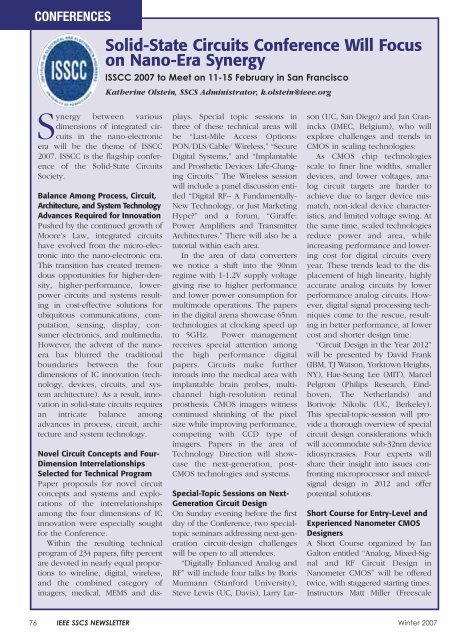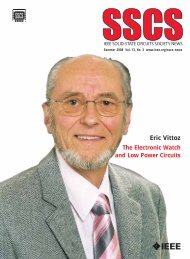The Impact of Dennard's Scaling Theory - IEEE
The Impact of Dennard's Scaling Theory - IEEE
The Impact of Dennard's Scaling Theory - IEEE
- TAGS
- scaling
- www.ieee.org
You also want an ePaper? Increase the reach of your titles
YUMPU automatically turns print PDFs into web optimized ePapers that Google loves.
CONFERENCES<br />
Synergy between various<br />
dimensions <strong>of</strong> integrated circuits<br />
in the nano-electronic<br />
era will be the theme <strong>of</strong> ISSCC<br />
2007. ISSCC is the flagship conference<br />
<strong>of</strong> the Solid-State Circuits<br />
Society.<br />
Balance Among Process, Circuit,<br />
Architecture, and System Technology<br />
Advances Required for Innovation<br />
Pushed by the continued growth <strong>of</strong><br />
Moore’s Law, integrated circuits<br />
have evolved from the micro-electronic<br />
into the nano-electronic era.<br />
This transition has created tremendous<br />
opportunities for higher-density,<br />
higher-performance, lowerpower<br />
circuits and systems resulting<br />
in cost-effective solutions for<br />
ubiquitous communications, computation,<br />
sensing, display, consumer<br />
electronics, and multimedia.<br />
However, the advent <strong>of</strong> the nanoera<br />
has blurred the traditional<br />
boundaries between the four<br />
dimensions <strong>of</strong> IC innovation (technology,<br />
devices, circuits, and system<br />
architecture). As a result, innovation<br />
in solid-state circuits requires<br />
an intricate balance among<br />
advances in process, circuit, architecture<br />
and system technology.<br />
Novel Circuit Concepts and Four-<br />
Dimension Interrelationships<br />
Selected for Technical Program<br />
Paper proposals for novel circuit<br />
concepts and systems and explorations<br />
<strong>of</strong> the interrelationships<br />
among the four dimensions <strong>of</strong> IC<br />
innovation were especially sought<br />
for the Conference.<br />
Within the resulting technical<br />
program <strong>of</strong> 234 papers, fifty percent<br />
are devoted in nearly equal proportions<br />
to wireline, digital, wireless,<br />
and the combined category <strong>of</strong><br />
imagers, medical, MEMS and dis-<br />
Solid-State Circuits Conference Will Focus<br />
on Nano-Era Synergy<br />
ISSCC 2007 to Meet on 11-15 February in San Francisco<br />
Katherine Olstein, SSCS Administrator, k.olstein@ieee.org<br />
plays. Special topic sessions in<br />
three <strong>of</strong> these technical areas will<br />
be “Last-Mile Access Options:<br />
PON/DLS/Cable/ Wireless,” “Secure<br />
Digital Systems,” and “Implantable<br />
and Prosthetic Devices: Life-Changing<br />
Circuits.” <strong>The</strong> Wireless session<br />
will include a panel discussion entitled<br />
“Digital RF– A Fundamentally-<br />
New Technology, or Just Marketing<br />
Hype?” and a forum, “Giraffe:<br />
Power Amplifiers and Transmitter<br />
Architectures.” <strong>The</strong>re will also be a<br />
tutorial within each area.<br />
In the area <strong>of</strong> data converters<br />
we notice a shift into the 90nm<br />
regime with 1-1.2V supply voltage<br />
giving rise to higher performance<br />
and lower power consumption for<br />
multimode operations. <strong>The</strong> papers<br />
in the digital arena showcase 65nm<br />
technologies at clocking speed up<br />
to 5GHz. Power management<br />
receives special attention among<br />
the high performance digital<br />
papers. Circuits make further<br />
inroads into the medical area with<br />
implantable brain probes, multichannel<br />
high-resolution retinal<br />
prosthesis. CMOS imagers witness<br />
continued shrinking <strong>of</strong> the pixel<br />
size while improving performance,<br />
competing with CCD type <strong>of</strong><br />
imagers. Papers in the area <strong>of</strong><br />
Technology Direction will showcase<br />
the next-generation, post-<br />
CMOS technologies and systems.<br />
Special-Topic Sessions on Next-<br />
Generation Circuit Design<br />
On Sunday evening before the first<br />
day <strong>of</strong> the Conference, two specialtopic<br />
seminars addressing next-generation<br />
circuit-design challenges<br />
will be open to all attendees.<br />
“Digitally Enhanced Analog and<br />
RF” will include four talks by Boris<br />
Murmann (Stanford University),<br />
Steve Lewis (UC, Davis), Larry Lar-<br />
son (UC, San Diego) and Jan Craninckx<br />
(IMEC, Belgium), who will<br />
explore challenges and trends in<br />
CMOS in scaling technologies:<br />
As CMOS chip technologies<br />
scale to finer line widths, smaller<br />
devices, and lower voltages, analog<br />
circuit targets are harder to<br />
achieve due to larger device mismatch,<br />
non-ideal device characteristics,<br />
and limited voltage swing. At<br />
the same time, scaled technologies<br />
reduce power and area, while<br />
increasing performance and lowering<br />
cost for digital circuits every<br />
year. <strong>The</strong>se trends lead to the displacement<br />
<strong>of</strong> high linearity, highly<br />
accurate analog circuits by lower<br />
performance analog circuits. However,<br />
digital signal processing techniques<br />
come to the rescue, resulting<br />
in better performance, at lower<br />
cost and shorter design time.<br />
“Circuit Design in the Year 2012”<br />
will be presented by David Frank<br />
(IBM, TJ Watson, Yorktown Heights,<br />
NY), Hae-Seung Lee (MIT), Marcel<br />
Pelgrom (Philips Research, Eindhoven,<br />
<strong>The</strong> Netherlands) and<br />
Borivoje Nikolic (UC, Berkeley).<br />
This special-topic-session will provide<br />
a thorough overview <strong>of</strong> special<br />
circuit design considerations which<br />
will accommodate sub-32nm device<br />
idiosyncrasies. Four experts will<br />
share their insight into issues confronting<br />
microprocessor and mixedsignal<br />
design in 2012 and <strong>of</strong>fer<br />
potential solutions.<br />
Short Course for Entry-Level and<br />
Experienced Nanometer CMOS<br />
Designers<br />
A Short Course organized by Ian<br />
Galton entitled “Analog, Mixed-Signal<br />
and RF Circuit Design in<br />
Nanometer CMOS” will be <strong>of</strong>fered<br />
twice, with staggered starting times.<br />
Instructors Matt Miller (Freescale<br />
76 <strong>IEEE</strong> SSCS NEWSLETTER Winter 2007




